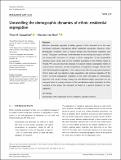Files in this item
Unravelling the demographic dynamics of ethnic residential segregation
Item metadata
| dc.contributor.author | Kauppinen, Timo M. | |
| dc.contributor.author | van Ham, Maarten | |
| dc.date.accessioned | 2018-08-27T10:30:07Z | |
| dc.date.available | 2018-08-27T10:30:07Z | |
| dc.date.issued | 2018-08-24 | |
| dc.identifier | 254018130 | |
| dc.identifier | fe4c3bb7-803f-4447-8b7a-eb0ba788e73c | |
| dc.identifier | 85052368431 | |
| dc.identifier | 000461078200014 | |
| dc.identifier.citation | Kauppinen , T M & van Ham , M 2018 , ' Unravelling the demographic dynamics of ethnic residential segregation ' , Population, Space and Place , vol. Early View , e2193 . https://doi.org/10.1002/psp.2193 | en |
| dc.identifier.issn | 1544-8444 | |
| dc.identifier.other | ORCID: /0000-0002-2106-0702/work/64697481 | |
| dc.identifier.uri | https://hdl.handle.net/10023/15881 | |
| dc.description | The research leading to these results has received funding from the European Research Council under the European Union's Seventh Framework Programme (FP/2007-2013) / ERC Grant Agreement n. 615159 (ERC Consolidator Grant DEPRIVEDHOODS, Socio-spatial inequality, deprived neighbourhoods, and neighbourhood effects). | en |
| dc.description.abstract | Selective intra-urban migration of ethnic groups is often assumed to be the main micro-level mechanism reproducing ethnic residential segregation. However, other demographic processes, such as natural change and international migration, also matter. This paper contributes to the literature by unravelling the impacts of different demographic processes to changes in ethnic segregation. It uses longitudinal individual-level register data on the complete population of the Helsinki region in Finland. We calculate observed changes in exposure indices, segregation indices in counterfactual scenarios, and decompositions of population changes. Results indicate that intra-regional migration is the main process affecting segregation between Finnish-origin and non-Western-origin populations, but whereas migration of the former increases segregation, migration of the latter decreases it. International migration and natural change among the non-Western-origin population are the main processes increasing exposure of the non-Western-origin population to other members of the group. No indication is found of a general tendency to "self-segregate". | |
| dc.format.extent | 671896 | |
| dc.language.iso | eng | |
| dc.relation.ispartof | Population, Space and Place | en |
| dc.subject | Ethnic segregation | en |
| dc.subject | Immigrants | en |
| dc.subject | Population dynamics | en |
| dc.subject | Decomposition | en |
| dc.subject | Finland | en |
| dc.subject | GF Human ecology. Anthropogeography | en |
| dc.subject | HT Communities. Classes. Races | en |
| dc.subject | 3rd-DAS | en |
| dc.subject.lcc | GF | en |
| dc.subject.lcc | HT | en |
| dc.title | Unravelling the demographic dynamics of ethnic residential segregation | en |
| dc.type | Journal article | en |
| dc.contributor.sponsor | European Research Council | en |
| dc.contributor.institution | University of St Andrews. School of Geography & Sustainable Development | en |
| dc.identifier.doi | https://doi.org/10.1002/psp.2193 | |
| dc.description.status | Peer reviewed | en |
| dc.identifier.grantnumber | ERC-2013-CoG | en |
This item appears in the following Collection(s)
Items in the St Andrews Research Repository are protected by copyright, with all rights reserved, unless otherwise indicated.

